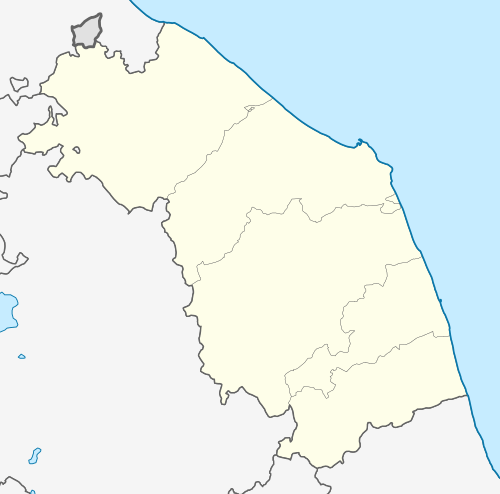Ascoli Piceno railway station
Ascoli Piceno | |
|---|---|
 | |
| Location |
Piazza della Stazione 63100 Ascoli Piceno AP Ascoli Piceno, Ascoli Piceno, Marche Italy |
| Coordinates | 42°51′19″N 13°35′17″E / 42.85528°N 13.58806°ECoordinates: 42°51′19″N 13°35′17″E / 42.85528°N 13.58806°E |
| Operated by |
Rete Ferroviaria Italiana Centostazioni |
| Line(s) | San Benedetto del Tronto–Ascoli Piceno |
| Distance |
32.582 km (20.246 mi) from Porto d'Ascoli |
| Train operators | Trenitalia |
| Connections |
|
| Other information | |
| Classification | Silver |
| History | |
| Opened | 1 May 1886 |
| Location | |
 Ascoli Piceno Location within Marche | |
Ascoli Piceno railway station (Italian: Stazione di Ascoli Piceno) serves the town and comune of Ascoli Piceno, in the region of Marche, central Italy. Opened in 1886, it is the southwestern terminus of the San Benedetto del Tronto–Ascoli Piceno railway, a branch of the Adriatic railway.
The station is managed by Rete Ferroviaria Italiana (RFI). The commercial area of the passenger building is managed by Centostazioni. Train services are operated by Trenitalia. Each of these companies is a subsidiary of Ferrovie dello Stato (FS), Italy's state-owned rail company.
Location
Ascoli Piceno railway station is situated at Piazza della Stazione, to the east of the town centre.
History
The station was opened on 1 May 1886, together with the rest of the San Benedetto del Tronto–Ascoli Piceno railway.[1]
The original operator of the station was the Società per le Strade Ferrate Meridionali (SFM) (English: Company for the Southern Railways), which operated the whole of the Ascoli Piceno branch as part of the Rete Adriatica (English: Adriatic Network). The SFM continued to operate the branch until the nationalization of the Italian railways in 1905.
Features
Passenger Building
Ascoli Piceno's passenger building is a two-storey structure, comprising three sections. It is made of brick and painted brown.
The central section of the building has six mullioned windows topped by arches, and its first floor windows are decorated with cornices. The ground floor of that section houses services for passengers, but the first floor is not accessible to the public.
Extending laterally from the central section are two symmetrical single-storey wings.
Station yard
The station yard consists of three tracks dedicated to passenger transport. In detail:
- Track 1: is a siding track.
- Track 2: lines up directly with the running track.
- Track 3: is another siding track.
The tracks are all passing tracks, because although the station is the terminal, each track ends about 50 metres (160 ft) outside the station. All tracks have a platform, and are connected by a concrete walkway. Only one track is covered by a canopy, which is made of wrought iron.
The station yard is also equipped with a group of sidings dedicated to the storage of vehicles not in service. These sidings are connected with the platforms by a bridge. There is a locomotive shed, and a goods shed of a design typical to Italian railway stations. The former goods yard has been dismantled, and the goods shed is disused.
From the station yard, a number of spur lines extend to nearby industrial sidings. Some of these spur lines are made partially of tramway tracks, at points where the line previously intersected with asphalt covered roadway.
Train movements
Only regional trains stop at the station. Their main origins and destinations are San Benedetto del Tronto, Macerata and Ancona.
Interchange
In the square in front of the passenger building is a bus terminal for urban and suburban buses. The operator of the bus service is START.
See also
- History of rail transport in Italy
- List of railway stations in the Marche
- Rail transport in Italy
- Railway stations in Italy
References
- ↑ Alessandro Tuzza; et al. "Prospetto cronologico dei tratti di ferrovia aperti all'esercizio dal 1839 al 31 dicembre 1926" [Chronological overview of the features of the railways opened between 1839 and 31 December 1926]. Trenidicarta.it (in Italian). Alessandro Tuzza. Retrieved 20 January 2011.
External links
This article is based upon a translation of the Italian language version as at January 2011.